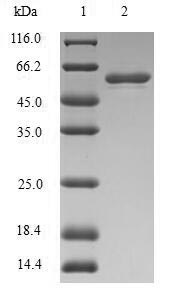The expression of recombinant human MMP3 protein includes the construction of the expression vector containing the recombinant DNA and the transformation of the expression vector into the E.coli, which provides a variety of macromolecules and components required for transcription and translation. The recombinant DNA was formed by fusing the N-terminal 6xHis-SUMO tag sequence to the designated sequence encoding the 102-477aa of the human MMP3 protein. This N-terminal 6xHis-tagged recombinant human MMP3 protein is also characterized by high purity, >90%. Under SDS-PAGE condition, this recombinant MMP3 protein migrated to the band of about 55 kDa molecular weight.
As the member of MMPs family, MMP3 is often involved in the modulation of endometrial inflammation and innate immunity. MMP-3 is composed of a signal peptide, which is cleaved off during the secretion process, a pro-domain, which is cleaved during the activation process, a catalytic domain which has a conserved zinc-binding site, a hinge domain, and a hemopexin domain. MMP3 expression was also detected at different intensity of inflammatory response. Importantly, MMP3 has been identified as a valuable marker for patients with COVID‐19. In addition, MMP3 directly correlates with bovine endometritis, and its increasing may contribute to progression of bovine endometritis. Presently, MMP3 plays an important role in the pathology of rheumatoid arthritis (RA) and ankylosing spondylitis (AS). High levels of act-MMP-3 expression were observed in human synovial membrane culture and oncostatin M and TNF-α stimulated human cartilage. But further studies are required to clarify, whether act-MMP-3 can serve as a predictive marker for outcome in chronic rheumatoid disorders.






